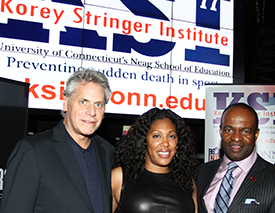
Advisors; Kelci Stringer; and DeMaurice Smith,
executive director, NFL Players Association.
With warm weather settling in, most of us start thinking of beaches and cookouts, but the arrival of summer has more serious implications for the National Football League Players Association.
Mindful of the danger of heat for its members, the NFLPA sponsored a fundraising dinner for the Korey Stringer Institute at the University of Connecticut, which works to prevent sudden death in sport and physical activity.
“The sold-out event was held during the week of the NFL draft, an event that focuses lots of attention on football, not only by players and fans but also by sports medicine physicians, athletic trainers, and coaches,” says Douglas Casa, Ph.D., a professor and director of athletic training in the Department of Kinesiology at the Neag School of Education and chief operating officer for the Korey Stringer Institute. “The NFLPA’s support for our health and safety initiatives allows us to continue our research and campaign for better policies for athletes and others involved in physical activities outdoors, such as soldiers and laborers.” Twelve current NFL players and 10 former players attended the event, which raised more than $30,000.
“The Korey Stringer Institute’s mission is one that aligns with the NFLPA’s focus on establishing a safer work place and a broader culture of safety,” said NFLPA staff counsel Sean Sansiveri. “The KSI has done so much to address athlete-specific health and safety issues such as hydration and heatstroke, the NFLPA was proud to support the Institute on its third anniversary with the ‘Players Helping Players’ gala. It was a sophisticated event that allowed current and former players to interact directly with individuals making a difference in the medical and patient-awareness fields. Holding the event in New York City the week of the Draft and on the eve of the NFLPA’s Mackey-White Committee meeting allowed us to introduce many of our medical advisors and business partners to the KSI and its work.”
Founded by Kelci Stringer, wife of Minnesota Viking lineman Korey Stringer who died in 2010 from exertional heat stroke during a preseason football practice, the institute provides research and advocacy for health and safety initiatives that help prevent sudden death in sport. The KSI has four corporate partners: the NFL, Gatorade, Timex, and CamelBak.
Casa has produced more than 140 peer-reviewed publications on heat and hydration topics and he helped develop health-acclimatization guidelines for secondary school athletics designed to reduce the risk of exertional heat illness during preseason practice periods. The guidelines have been adopted by 10 states and the institute is working with 15 other states to get them to adopt the guidelines. They eliminate intense two-a-day workouts at the start of preseason and allow athletes to adjust to exertion in hot weather through phased-in practices.
“Today, 10 states have adopted the guidelines, compared to none two years ago,” says Casa. “It can take baby steps,” says Casa, who survived heatstroke as a teen distance runner. “When Texas first approved guidelines, they didn‘t meet our minimum standards, but advocates kept working at it. Now, there’s some momentum for the guidelines tugging at states a little bit. Our goal is to them approved before there is a tragedy.”
More than 9,000 high school athletes are treated for exertional heat illness annually, according to a 2010 study from the Centers for Disease Control and Prevention.
Research by the Korey Stringer Institute with Ohio State University and the University of North Carolina found that nearly 75 percent of the cases of heat illness occurred in football. The study analyzed data collected from 2005 to 2011 by the National High School Sports-Related Injury Surveillance System.
“We are working to get the information out to physicians, athletic trainers, teachers, coaches, parents, and athletes that death from exertional heat stroke is 100 percent preventable, and that many policies need to change to enhance the health and safety of athletes” says Casa.
 Facebook
Facebook
 Twitter
Twitter
 LinkedIn
LinkedIn
